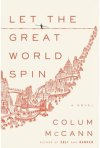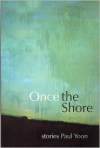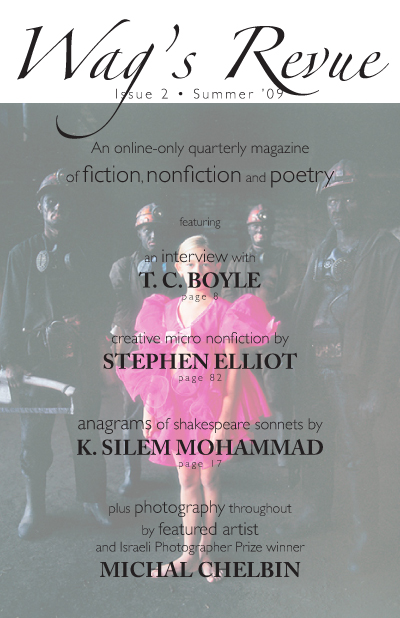Live Nude Books: The characters in these stories are very well developed—you shed light on their pasts, and often you get into the heads of several characters in a single story—yet, as a reader, it never feels like I’m being overwhelmed with information. How do you go about developing characters without overloading the reader?
David McGlynn: Reading a story is sort of like sitting next to a stranger on an airplane. You’re willing to listen to the stranger’s life story so long as it’s interesting. Most of these conversations go awry, not because the stranger doesn’t have a good story to tell but because he or she doesn’t properly gauge how much of it to include. Some background information is important, perhaps even crucial, but back up too far or include too much and your listener tunes out. The balance isn’t easy to strike, but the airplane analogy offers at least a little guidance: we all know when we’ve hit the point when we’ve heard too much, when we’ve lost interest, and when we’re being overwhelmed. The trouble is, the fiction writer isn’t the guy beside the stranger; he’s the stranger, or at least he’s pretending to be. The fiction writer has to know as much as possible about his or her people in order to figure which details to include and which to leave out.
When I began working on the stories in The End of the Straight and Narrow, I had absolutely no idea—and I mean no idea—how to achieve such a balance. I opted for more, rather than less, knowledge, and for several years I sat in the library and wrote, by hand, explorations into the psychologies and emotions of each of my people. I’d been struggling with the stories for a while and none of the scenes I’d concocted seemed any good, so I allowed myself to concentrate on simply understanding the person. I allowed each character to become the chatty grandmother on the airplane and I her indulgent listener. Whatever they wanted to tell me, no matter how mundane or idiotic, I wrote down. To my surprise, I found that once I got a character talking, scenes appeared. I imagined whole conversations, interactions and arguments; it was as though the characters woke up for me and started walking around. I don’t mean for this to sound mystical: I’d been working on these stories, and thus these people, for a long time, and a few things finally started to make sense to me. I ended up with several hundred hand-written pages, which I still have in a drawer. A lot of it was garbage, but among the junk were a few meaty, dramatic scenes or observations that seemed to capture the entire person. When I finally went back to make the stories, to draft and revise them, I was able to extract those keys scenes and moments and feel confident that they could bear the weight of the information I was leaving out.
LNB: Do you consider audience when writing stories?
DM: I don’t write with a specific audience in mind, and I don’t think most writers of literary fiction do, either. I’m not, for example, writing specifically to men or women or college students or working professionals; I hope that people from each of those groups will find something interesting in my work. One of the dangers I face is being branded—given my interested in evangelicals—as a “Christian Writer,” the kind of writer you find in a Christian bookstore or in the “Inspirational” section at Barnes and Noble. Anyone who reads my stories will see that though many of my characters are tussling with the vicissitudes of Christian faith, they’re complicated and conflicted human beings. They have passions, and quite often make impulsive, irrevocably consequential decisions on the basis of those passions. For me, religion is the lens through which I strive to see my characters, and to get my characters to see the world. Every character has a lens though which she sees and is seen, be it her gender or ethnicity or geography or cultural assumptions. Religion is just one of the clubs in the bag, though in my bag, it’s a big one. It’s a 1-wood driver.
That said, I got interested in writing about religious people in part because religious folks—especially evangelicals—are often mischaracterized or lampooned. They’re often shown in gigantic stadium-like churches filled with rock bands and strobe lights and people swooning in the aisles. Or, they’re shown demonstrating outside courthouses, seemingly in lock-step with Jerry Falwell and Pat Robertson. Such depictions aren’t totally unwarranted, but the picture of all those people swaying en masse seems to suggest that these people simplistic and homogenous, that they lack inner lives, or that their inner lives are constituted entirely by doctrinal maxims. Like all people, evangelicals are in possession of a complex psychology. They have reasons for their beliefs, and those reasons are deeply rooted in their personal experiences and traumas. Despite all their rhetoric promoting chastity and conservative gender relationships, they, too, have fervent sexual desires. It’s probably a topic for another time, but I believe evangelicalism is a highly eroticized religious world; it practically oozes with sexual desire and innuendo, it’s just that it gets wrapped up in a spiritual package that makes it look like something different. But again, you can see the contradiction at work—people who spend a good deal of time simultaneously talking about and abstaining from sex. They’re often lampooned for this, but lampoons rely, for the most part, on superficialities. I felt these people needed a more complex voice. Ultimately, though, I hope readers will find their way to my work because I’m telling good stories; the fact that I’m telling stories about the crazy religious people down the street who often go to church twice on Sundays, as well as on Wednesday nights, only adds to the mystery and to the appeal.
LNB: Disaster—whether natural or biological—appears frequently in these stories, in conjunction with themes of faith, guilt, regret, redemption, and desire. When drafting a story, do you develop themes from the subject matter, or do you have a theme(s) in mind and try to find a premise that works to enhance it (them)?
DM: Always the former, always from the subject matter. In fact, in a number of cases, the disasters got the stories off the ground. I’m connected, in one way or another, to almost all of the disasters in the book. My father and stepmother nearly lost their house during the 1993 Laguna Beach fires, which later inspired “Moonland on Fire”; I was coaching a swimming workout in 2001 when a close friend had a heart attack in the water and could not be revived; my mother temporarily lost her eyesight just before going into labor with me; and, as a Texan, I’ve weathered my share of hurricanes. My mother used to take my sister and I into the laundry room to ride out the storms, much like Cordelia takes Rowdy and Jill into the laundry room in the final story, “The End of the Straight and Narrow.” Some things I witnessed—like my friend’s heart attack—but most I didn’t. I heard about them later and my imagination was seized by the story. In each case, a single, strange image emerged that sparked my interest: a boy watching his father pray over his house while a massive fire rages in the background, a lonely woman talking to the baby she gave up years ago, and so on. The image, the possibility of a scene, got me going and I went from there.
I also like disasters because they’re dramatic: the sky flashes, the great sea yearns, and against them, human beings also flash and yearn. Communities come together, or else splinter apart, during disasters. People say the things they wouldn’t ordinarily have the courage to say. They take leaps of faith, and leaps of faith are profoundly important to me. Flannery O’Connor says in Mysteries and Manners, “For the fiction writer, to believe nothing is to see nothing.” O’Connor’s says this sentence within the context of religion, her Catholic faith in particular, but I also think she means something even broader. Every story, regardless of its context or subject, is an act of faith and belief. Writers begin with nothing, with blank pages, and believe that at the end of the process, real people will exist on the page. My faith is tested every time I sit down to write. It’s natural that I’d be drawn to stories in which the faiths of others are tested, too.
LNB: Part II of the book is comprised of five linked short stories. Did you originally intend on writing several stories about these characters? Did the thought of a novel ever cross your mind?
DM: Part II had a long gestation. It began as one failed story that turned into an entire failed novel. I wrote reams of pages that added up to nothing. All those pages I talk about above were part of an attempt to find my way out. I was ready to abandon the entire thing when, a few months before my oldest son was born, I thought I’d see if I could extract enough material to make a single story. Just one story, I told myself, and I can leave the work behind without it being a total waste. The story I wrangled out was “Consequences of Knowledge,” the middle story in the sequence. I looked at what I’d made and felt pleased with it. I thought, I bet I can do this one more time. “Sweet Texas Angel” came next, and by the time it was finished, I believed I could do three more, one at the beginning and two more at the end. I had plenty of material to draw from, so I had the scenes. The novel had given me a lot of trouble because I couldn’t seem to find a way to link one chapter to another; it felt like I was writing filler most of the time. Once I gave up the need to write chapters and allowed myself to freedom to make larger leaps across time and points of view, I had a much clearer sense of what to do. Ironically, the process taught me how a novel might go together, how I might survive the writing of one. I’m a long-winded writer, with a fairly long attention span, so I believe I have a novelist’s heart, so long as I can work in small, prismatic segments, and take my time.
LNB: Have you written, or have you thought about writing, more stories involving these characters?
DM: Not as of yet. By the time these stories were finished, I felt the way Andy Roddick must have felt after this year’s Wimbledon match against Roger Federer: bereft, exhausted, and simply relieved it was over. More importantly, the characters in Part II sustained my writing life by presenting to me certain, persistent questions: for example, why Cory allowed herself to give up her own child for the sake of the Jarretts, and why Rowdy was so obsessed with his guilt about his mother’s blindness. Completing the stories answered those questions for me, more or less, and as a result, the characters don’t feel as mysterious or as elusive as they once did. I now realize that the very things that used to terrify me as a writer—what I don’t understand about a character—actually keep me going. If there’s something more that I don’t know, then there’s something more I can discover. There’s a problem I can solve. I’m eager to unravel someone else’s mysteries now.
LNB: What are currently working on?
DM: I’m working on a collection of creative nonfiction essays. Some days I call it a memoir-in-essays, but I’ve never particularly liked the word memoir, so most of the time I call it a collection of essay. A number of the essays are about swimming, and the title essay, “Rough Water” is forthcoming in the 2009 Best American Sports Writing anthology. Swimming is one of my lifelong passions; I was a competitive swimmer throughout high school and college, and remain somewhat competitive today (I race a few times a year), and each essay in the collection wends it way toward water in one way or another. In one essay, I tell about getting lost in the Utah desert. In another, I tell about worrying about the plumbing in my house—convinced the pipes are leaking inside the walls—while my wife and I worry over the results of an amniocentesis, which will determine whether or not our second child will have a very grave genetic disease. The essays aren’t just about swimming, though. They’re also about my family, growing up in the suburbanized American West, money, hunger, sex, and religion. The first few essays were written during the writing of The End of the Straight and Narrow, so my obsessions and fascinations with religion that characterize my fiction also show up in my nonfiction.
LNB: What have you recently read that you’re telling everyone about?
DM: I recently read C.J. Hribal’s novel, The Company Car. I’d heard great things about Hribal from a number of friends, but I’d never read any of his work. I heard him read from the novel last spring at the Fox Cities Book Festival, and was immediately entranced. He’s a great reader of his work, which helps. I pulled out my last bit of cash, bought the book, had him sign it, and then took it home and dove right in. It’s a big, sprawling, but endlessly entertaining and ultimately magical work of fiction. I savored it. I’m also licking my chops for Jill McCorkle’s new book of stories. The last two stories of hers that I’ve read, “Magic Words” and “Another Dimension” have been fabulous. “Magic Words” will be in the 2009 Best American Short Stories. And she’s one of the nicest people I’ve ever met, so she deserves all the praise and acclaim that comes her way. As far as nonfiction goes, Willard Spiegelman’s Seven Pleasures: Essays on Ordinary Happiness is not to be missed. Spiegelman’s an academic (and editor of the Southwest Review), so the essays are intelligent, classical, and highly literary. Anyone who reads the book will learn a new word or two. But the essays are also funny, poignant, cheerful, and simply sanguine. In the book, he talks about how watching people do something pleasurable, such as dance, can make you feel happy. It turns out that reading a writer in a good mood can have the same effect.
 Since its late June release, I’ve read some fantastic reviews of this book. The late great Frank McCourt (whose review can be read by clicking on the book title link above, and scrolling halfway down the page) said, “This is fiction that gets the heart thumping,” and, “this is a great New York book, not just for New Yorkers but for anyone who walks any sort of tightrope at all.”
Since its late June release, I’ve read some fantastic reviews of this book. The late great Frank McCourt (whose review can be read by clicking on the book title link above, and scrolling halfway down the page) said, “This is fiction that gets the heart thumping,” and, “this is a great New York book, not just for New Yorkers but for anyone who walks any sort of tightrope at all.”
 If you’re interested in quality online reading, here’s a great site to check out:
If you’re interested in quality online reading, here’s a great site to check out: 
